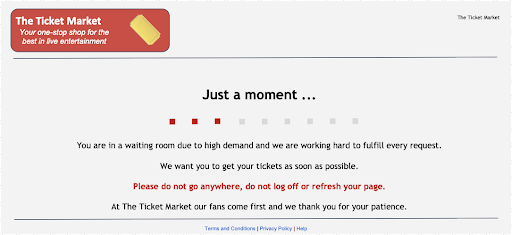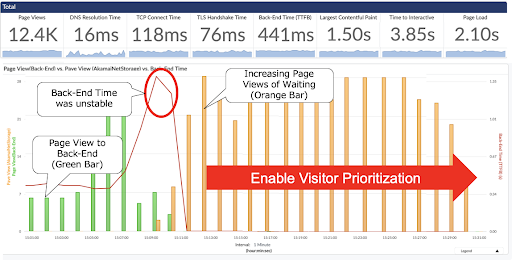Visualize Visitor Prioritization in Real Time with mPulse

COVID-19 is changing our behavior as we try to avoid person-to-person contact. For example, according to the Google Mobility Report, September 2020 shows an average 23% drop in retail and recreation activity and a 22% drop in workplace traffic in Tokyo compared to a baseline average before COVID-19 — a significant shift even though the state of emergency was lifted by the Japanese government on May 25, 2020.
With more people going online for socialization, entertainment, shopping, and work, internet demand is increasing. Akamai saw a 30% increase in web traffic in March 2020, establishing a new record of 167 Tbps delivered by the Akamai network with streaming coverage of European football matches and multiple patch releases in Q1 2020, which was double the traffic of Q1 2019.
Handling a surge in traffic is a challenge. A spike in demand can overload servers, slowing your website or causing outages. If this happens, visitors become frustrated and abandon your site, sometimes never to return. Poor user experience deteriorates brand image and negatively impacts business. With online activity at an all-time high, it has never been more important to understand the user experience.
Real user monitoring (RUM) tracks how your website is responding to users. It captures key performance metrics — such as page load time — by running JavaScript on a client web browser for important insight into the user experience and service availability. When a website goes down due to unexpected load, a browser might produce an unwelcome error screen. To avoid this scenario, a content delivery network (CDN) platform can reroute traffic that exceeds the capacity of application servers to a more user-friendly waiting room.
 Fig. 1: User-friendly waiting room
Fig. 1: User-friendly waiting room
Akamai delivers the RUM and Visitor Prioritization capabilities designed to ensure visitors don’t encounter an error screen on your website due to high traffic volume. When used together, these capabilities provide automated, real-time visibility into the user experience under peak conditions.
 Fig. 2: Error screen caused by high traffic volume
Fig. 2: Error screen caused by high traffic volume
Using mPulse to visualize visitor prioritization in real time
The Akamai mPulse RUM solution monitors web performance and visitor prioritization to improve user experiences. mPulse collects a variety of measurements from traditional quality benchmarks like Navigation Timing, to modern performance signals like Web Vitals, and key performance indicator (KPI) metrics for your business. It correlates performance with real user behavior and business metrics so you can understand how fast your website should be. It also analyzes outside factors that can impact your website, such as third-party scripts.
To provide business continuity during peak traffic, Akamai offers an easy-to-deploy waiting room application. The Visitor Prioritization Cloudlet acts as a front-end shock absorber when spikes in traffic increase demand for transactions that require the origin servers for processing, such as shopping carts, donation pages, application subscriptions, and form registrations. During a peak event, static content you prepare in advance is delivered from the Akamai platform to help you provide positive user experiences.
Monitoring user experience during peaks with mPulse
mPulse has a feature that allows separate dimensions by value sources such as JavaScript Variable, Query Strings, User Agent, and so on. Since Visitor Prioritization sets cookies, mPulse can take advantage of the cookies for a custom dimension.
 Fig. 3: mPulse uses cookies for a custom dimension
Fig. 3: mPulse uses cookies for a custom dimension
The mPulse dashboard below is an example dashboard that visualizes Visitor Prioritization.
 Fig. 4: A visualization of Visitor Prioritization
Fig. 4: A visualization of Visitor Prioritization
The green bar shows the page views to a dynamic application (back-end) server. The orange bar shows the page views of the waiting room on Akamai NetStorage — globally distributed, high-availability cloud storage on the Akamai platform. Once back-end time becomes unstable, Visitor Prioritization kicks in. After that, the orange bar increased, which means users were waiting on the Akamai platform because of Visitor Prioritization. Instead of an unfriendly error page, they saw the prepared content and waited until the back-end server was back to normal.
In addition to monitoring mPulse dashboards to understand the user experience, you can configure alerts to notify you when something happens to your web service.
Creating mPulse alerts
mPulse can set an alert like the one shown below when the beacon counts on the specific page group are greater than the threshold. As a result, you don’t need to open the mPulse portal to see the page views.
 Fig. 5: An example mPulse alert setup
Fig. 5: An example mPulse alert setup
Automating visitor prioritization
If your company has a DevOps culture, you can activate the configuration of Visitor Prioritization via the Cloudlets API. mPulse alerts allow us to send a webhook that can be customized. Therefore, you can prepare a server that calls the Cloudlets API from mPulse alerts to automatically activate Visitor Prioritization so you no longer need to monitor and track the data manually.
 Fig. 6: With mPulse, you can send a customized webhook
Fig. 6: With mPulse, you can send a customized webhook
How to configure visitor prioritization and custom dimensions on mPulse
Configuring mPulse with Visitor Prioritization doesn’t require any changes on your origin server or the HTML file in the waiting room. When mPulse is enabled on the Akamai platform, the mPulse snippet is injected on our edge servers for both.
 Fig. 7: The mPulse snippet is injected into your origin server and the HTML file in the waiting room
Fig. 7: The mPulse snippet is injected into your origin server and the HTML file in the waiting room
It’s easy to create the configurations on the Akamai platform and mPulse portal. Let’s walk through each configuration.
Akamai platform (Property Manager)
In Visitor Prioritization Cloudlet behavior, you can set up the cookie name with “Instance Label” in Cookie Management. In the case shown below, our edge server sets a cookie called “akavpau_vp” for “Allowed User” since “akavpau_” is automatically preset. You can set another cookie name for the waiting room — in this case, “akavpwr_” is automatically preset.
 Fig. 8: Setting up a cookie name in Cookie Management
Fig. 8: Setting up a cookie name in Cookie Management
mPulse portal
After you identify the cookie names from the behavior, you can set up two custom dimensions with the cookies on mPulse (see screenshot below). Choose “Cookie” as a value source and input the cookie name. In “Regular Expression,” “(.*)” covers all values of the cookie and replaces it with the name “Allowed” on the replacement option to make it simple. Just as you set up “Allowed User,” “Waiting Room” can be configured with another cookie called “akavpwr_vpdenied” in this case. Now all configurations are ready.
 Fig. 9: Setting up two custom dimensions with the cookies on mPulse
Fig. 9: Setting up two custom dimensions with the cookies on mPulse
Prepare for peaks
The internet has become one of the most important access points in our daily lives. Unexpected surges in demand can slow web pages and create service outages for unprepared websites. A poor user experience leads to dissatisfied customers, making it more critical than ever to visualize and control online performance. Akamai can help you get a better understanding of the user experience and plan for peaks with mPulse and Visitor Prioritization.




